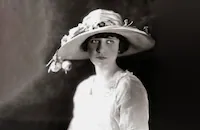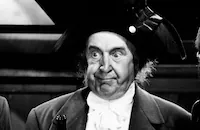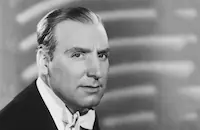Alexander Hamilton

Brief Synopsis
Cast & Crew
John G. Adolfi
George Arliss
Doris Kenyon
Dudley Digges
June Collyer
Montagu Love
Film Details
Technical Specs

Synopsis
Alexander Hamilton, the United States' first Secretary of the Treasury, is not popular with many of the senators or with the former Revolutionary War soldiers. He lobbies for a centralized government, which will assume and pay the war debt of the various states, but Senators Thomas Jefferson and James Monroe oppose him, believing that a centralized government will lead to monarchy. Hamilton makes a deal with his opposition by agreeing to support their plan to build a capitol on the Potomac River, halfway between the North and the South, in return for support for his Assumption Bill. Not everyone is happy with this plan, however. Senator Timothy Roberts arranges for Hamilton, whose beloved wife Betsy is in London caring for her seriously ill sister, to be seduced by Maria Reynolds, the wife of James Reynolds, a former Treasury employee who was dismissed for dishonesty. Hamilton's opponents use this affair in an attempt to blackmail him directly, but when that fails, Roberts gives the story to the newspapers, threatening to run it unless Hamilton withdraws his bill. Rather than compromise his beliefs, Hamilton confesses to the affair. Betsy, hurt by the revelations, decides to leave him, but changes her mind when Hamilton makes a sentimental gesture. In spite of the scandal, the Senate, Cabinet and President George Washington visit Hamilton to reaffirm their faith in him and to tell him that his bill has passed and will become law.

Director

John G. Adolfi
Cast

George Arliss

Doris Kenyon

Dudley Digges

June Collyer

Montagu Love

Ralf Harolde
Lionel Belmore

Alan Mowbray
John T. Murray
Morgan Wallace
John Larkin

Charles Middleton
Gwendolyn Logan
Charles Evans
Evelyn Hall
Russell Simpson
James Durkin
George Larkin
Crew
John Ellis
Perry Finnerman
Esdras Hartley
Maude Howell
Louis Jennings
Julian Josephson
Vernon Larson
Earl Luick
Owen Marks
David Mendoza
W. And J. Sloan
James Van Trees

Film Details
Technical Specs

Articles
Alexander Hamilton
Arliss's theatrical repertoire, which began in 1887 in his native England, often included the "Great Men of History." Around 1917, casting about for another subject to emulate his earlier Broadway successes, Arliss stumbled upon a script from an unlikely source, a New York housewife and aspiring playwright named Mary Hamlin. Ignorant of the usual channels for selling a play, Mrs. Hamlin had simply written directly to Arliss and asked if he might be interested in a piece about Alexander Hamilton, one of the most important framers of the U.S. federal system and the nation's first Secretary of the Treasury. Arliss responded favorably, and Hamlin sent him the first act which was all she had written. He liked what he read and saw commercial possibilities in playing an American historical figure at a time when nationalist fever was running high due to America's involvement in World War I.
According to Hamlin, Arliss thought the script for Alexander Hamilton needed some polishing by a "more practiced hand", and instead of passing it off to another playwright, he took on the task of adapting it himself. He and Hamlin worked well together, and years later he noted of her: "She was entirely unlike other untried dramatists that I had met. She never once wept over her own pathetic lines, nor did she ever refer to the play as her baby or even as her little papoose. I was very grateful to her for that. During our association in the writing of Hamilton her unselfish and generous attitude towards me surprised me always and left me ever her devoted friend." Under the direction of Dudley Digges (who would star in the film version), the stage production that came out of their efforts was a success and brought its star more fan mail than any play he ever appeared in.
By 1931 Arliss was firmly established at Warner Brothers and he sold the studio his and Hamlin's script. After disentangling from some legal complications involving the Broadway producers, two new writers were assigned to make it screen worthy (under the watchful eyes of the original authors). The story centered on two key moments in Hamilton's life and career: his efforts to establish a federal banking system and the near thwarting of that goal through an attempt to blackmail him over an earlier extramarital affair. Liberties were taken with historical fact, of course, but not nearly as many as most other biographical dramas of the time, including Arliss's own. The biggest liberty, however, was in the age discrepancy between star and subject; in his early 60s, Arliss was more than two decades older than Hamilton when the story takes place. Reviews were generally positive, however, and Alexander Hamilton made a modest profit, not as much as the studio had hoped but enough to carry the star through several more such characterizations, including turns as Voltaire, Cardinal Richelieu, and the first of the Rothschilds.
Hamilton, of course, died before he even turned fifty. An intelligent, aggressive, highly influential statesman and political theorist, and a close confidante of George Washington, he made many enemies in his career. Among them were Thomas Jefferson and James Madison (both of whom are depicted in this film), who regarded him as an aristocratic elitist and a danger to states' rights. But none were more bitterly opposed to him than Aaron Burr, one-time vice-president of the U.S. and a politician whose ambitions were equal to Hamilton's. The two fought a famous duel in 1804, and Hamilton was fatally shot. The story told by Alexander Hamilton, however, takes place several years before that incident.
The direction of Alexander Hamilton was entrusted to John G. Adolfi, a former silent screen actor and director who entered the film industry in 1913. In 1931, he and Arliss worked together for the first time on The Millionaire and hit it off. Adolfi directed eight more pictures over the next two years, all but two of them with Arliss. Their partnership would likely have continued if it hadn't been for 45-year-old Adolfi's sudden death from a cerebral hemorrhage while on a canoe trip in Canada.
Director: John G. Adolfi
Screenplay: Maude T. Howell, Julian Josephson, based on a play by George Arliss and Mary Hamlin
Cinematography: James Van Trees
Editing: Owen Marks
Art Direction: Esdras Hartley
Original Music: William D. Dunham
Cast: George Arliss (Alexander Hamilton), Doris Kenyon (Betsy Hamilton), Dudley Digges (Sen. Timothy Roberts), June Collyer (Mrs. Mariah Reynolds), Montagu Love (Thomas Jefferson), Alan Mowbray (George Washington).
BW-70m.
by Rob Nixon

Alexander Hamilton
Quotes
Trivia
Notes
According to Motion Picture Herald, the fictional character of "Senator Roberts" was added to the screenplay in order to placate both Democratic and Republican party leaders, who expressed concern over the way their parties were to be depicted. George Arliss played Hamilton in his Broadway production for two seasons. According to contemporary sources, Arliss requested actress June Collyer for the role of "Mrs. Reynolds," feeling that her association with more innocent roles would help her to seem like the kind of woman who might attract a man like Hamilton.















